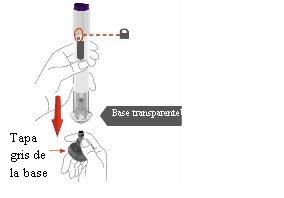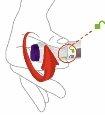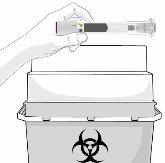
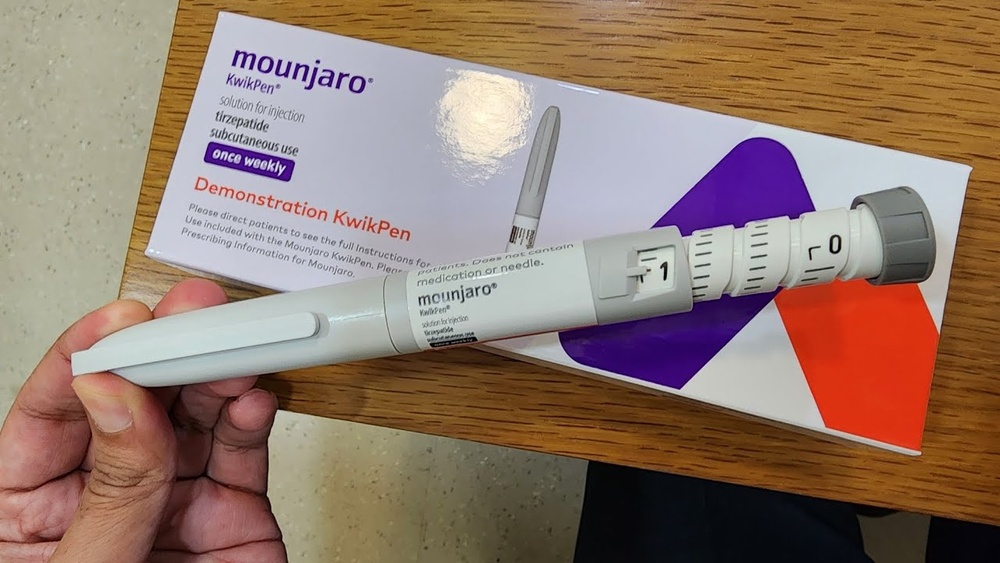
MOUNJARO 12.5 mg Injectable Solution in a Pre-filled Pen

Ask a doctor about a prescription for MOUNJARO 12.5 mg Injectable Solution in a Pre-filled Pen

How to use MOUNJARO 12.5 mg Injectable Solution in a Pre-filled Pen
Introduction
Package Leaflet: Information for the Patient
Mounjaro 2.5mg solution for injection in pre-filled pen
Mounjaro 5mg solution for injection in pre-filled pen
Mounjaro 7.5mg solution for injection in pre-filled pen
Mounjaro 10mg solution for injection in pre-filled pen
Mounjaro 12.5mg solution for injection in pre-filled pen
Mounjaro 15mg solution for injection in pre-filled pen
tirzepatide
This medicinal product is subject to additional monitoring, which will allow for quick identification of new safety information. You can help by reporting any side effects you may get. The last section of the package leaflet contains information on how to report side effects.
Read all of this leaflet carefully before you start using this medicine because it contains important information for you.
- Keep this leaflet, you may need to read it again.
- If you have any further questions, ask your doctor, pharmacist, or nurse.
- This medicine has been prescribed for you only. Do not pass it on to others. It may harm them, even if their signs of illness are the same as yours.
- If you get any side effects, talk to your doctor, pharmacist, or nurse. This includes any possible side effects not listed in this leaflet. See section 4.
Contents of the pack
- What is Mounjaro and what is it used for
- What you need to know before you use Mounjaro
- How to use Mounjaro
- Possible side effects
- Storage of Mounjaro
- Contents of the pack and other information
1. What is Mounjaro and what is it used for
Mounjaro contains the active substance tirzepatide and is used to treat adults with type 2 diabetes mellitus. Mounjaro lowers blood sugar levels only when blood sugar levels are high.
Mounjaro is also used to treat adults with obesity or overweight (with a BMI of at least 27 kg/m2). Mounjaro affects appetite regulation, which can help you eat less food and reduce your body weight.
In type 2 diabetes, Mounjaro is used:
- alone when you cannot take metformin (another diabetes medicine).
- or in combination with other diabetes medicines when these are not enough to control the sugar levels in your blood. These other medicines may be taken by mouth and/or may be an insulin injection.
Mounjaro is also used together with diet and exercise to lose weight and help keep weight under control in adults who have:
- a BMI of 30 kg/m² or more (obesity) or
- a BMI of at least 27 kg/m², but less than 30 kg/m² (overweight) and weight-related health problems (such as prediabetes, type 2 diabetes, high blood pressure, abnormal fat levels in the blood, breathing problems during sleep called "obstructive sleep apnea" or a history of heart attack, stroke, or vascular problems)
Body Mass Index (BMI) is a measure of your weight in relation to your height.
In patients with obstructive sleep apnea (OSA) and obesity, Mounjaro can be used with or without positive airway pressure (PAP) therapy.
It is important that you follow the advice about your diet and physical activity given by your doctor, nurse, or pharmacist.
2. What you need to know before you use Mounjaro
Do not use Mounjaro
- if you are allergic to tirzepatide or any of the other ingredients of this medicine (listed in section 6).
Warnings and precautions
Tell your doctor, pharmacist, or nurse before starting Mounjaro if:
- you have severe problems with digestion of food or food stays in your stomach for longer than usual (including severe gastroparesis).
- you have ever had pancreatitis (inflammation of the pancreas, which can cause severe pain in the stomach and back that does not go away).
- you have any problems with your eyes (diabetic retinopathy or macular edema).
- you are taking a sulfonylurea (another diabetes medicine) or insulin for diabetes, as low blood sugar (hypoglycemia) may occur. Your doctor may need to adjust the dose of these medicines to reduce this risk.
When starting treatment with Mounjaro, you may experience fluid loss/dehydration, such as vomiting, nausea, and/or diarrhea, which can cause a decrease in kidney function. To avoid dehydration, it is essential to drink plenty of fluids. Contact your doctor if you have any questions or concerns.
If you know you are going to have surgery, tell your doctor that you are taking Mounjaro.
Children and adolescents
This medicine must not be used in children and adolescents under 18 years because it has not been studied in this age group.
Other medicines and Mounjaro
Tell your doctor, pharmacist, or nurse if you are using, have recently used, or might use any other medicines.
Pregnancy
If you are pregnant or breast-feeding, think you may be pregnant, or are planning to have a baby, ask your doctor for advice before taking this medicine. This medicine must not be used during pregnancy because the effects of this medicine on the fetus are not known. Therefore, it is recommended to use contraceptive methods while using this medicine.
Breast-feeding
It is not known whether tirzepatide passes into breast milk. A risk to newborns/babies cannot be excluded. If you are breast-feeding or plan to breast-feed, ask your doctor for advice before taking this medicine. You and your doctor will decide whether you should stop breast-feeding or stop Mounjaro.
Driving and using machines
This medicine is unlikely to affect your ability to drive or use machines. However, if you use Mounjaro with a sulfonylurea or insulin, low blood sugar (hypoglycemia) may occur, which can reduce your ability to concentrate. Avoid driving or using machines if you have any signs of low blood sugar, such as headache, drowsiness, weakness, dizziness, hunger, confusion, irritability, rapid heartbeat, and sweating (see section 4). See section 2, "Warnings and precautions" for information on the increased risk of low blood sugar. Consult your doctor for more information.
Mounjaro contains sodium
This medicine contains less than 1 mmol of sodium (23 mg) per dose, which is essentially "sodium-free".
3. How to use Mounjaro
Follow the instructions for administration of this medicine exactly as told by your doctor or pharmacist. If you are not sure, ask your doctor or pharmacist again.
How much to use
- The initial dose is 2.5 mg once a week for four weeks. After four weeks, your doctor will increase your dose to 5 mg once a week.
- Your doctor may increase your dose in increments of 2.5 mg up to 7.5 mg, 10 mg, 12.5 mg, or 15 mg once a week if needed. In each case, your doctor will tell you to stay on a specific dose for at least 4 weeks before moving to a higher dose.
Do not change your dose unless your doctor tells you to.
Each pen contains a dose of Mounjaro of 2.5 mg, 5 mg, 7.5 mg, 10 mg, 12.5 mg, or 15 mg.
Choosing when to use Mounjaro
You can use your pen at any time of day, with or without food. If you can, you should use it on the same day each week. To help you remember when to use Mounjaro, you can write down the day of the week you inject your first dose on the carton of your pen or on a calendar.
If necessary, you can change the day of your weekly Mounjaro injection, as long as at least 3 days have passed since your last injection. After selecting a new dosing day, continue with once-weekly administration on that new day.
How to inject Mounjaro
Mounjaro is injected under the skin (subcutaneous injection) in the abdominal area at least 5 cm away from the navel or in the upper thigh or upper arm. You may need help from another person if you want to inject in the upper arm.
If you want, you can inject in the same area of your body each week. However, make sure to choose different injection sites within the same area. If you also inject insulin, choose a different injection site for that injection.
Before using Mounjaro, carefully read the "Instructions for use" of the pen.
Monitoring blood sugar levels
If you are using Mounjaro with a sulfonylurea or insulin, it is essential to monitor your blood sugar levels as instructed by your doctor, pharmacist, or nurse (see section 2, "Warnings and precautions").
If you use more Mounjaro than you should
If you use more Mounjaro than you should, talk to your doctor immediately. Too much medicine can cause your blood sugar levels to drop too low (hypoglycemia) and may also cause nausea or vomiting.
If you forget to use Mounjaro
If you forget to inject a dose and,
- 4 days or lesshave passed since you should have used Mounjaro, use it as soon as you remember. Then inject your next dose as usual on your scheduled day.
- If more than 4 dayshave passed since you should have used Mounjaro, skip the missed dose. Then inject your next dose as usual on your scheduled day.
Do not inject a double dose to make up for a missed dose. The minimum time between two doses must be at least 3 days.
If you stop using Mounjaro
Do not stop using Mounjaro without talking to your doctor. If you stop using Mounjaro and have type 2 diabetes, your blood sugar levels may increase.
If you have any other questions on the use of this medicine, ask your doctor, pharmacist, or nurse.
4. Possible side effects
Like all medicines, this medicine can cause side effects, although not everybody gets them.
Serious side effects
Uncommon(may affect up to 1 in 100 people)
- Pancreatitis (inflammation of the pancreas) that could cause severe stomach and back pain that does not go away. See your doctor immediately if you experience these symptoms.
Rare(may affect up to 1 in 1,000 people)
- Severe allergic reactions (e.g., anaphylactic reaction, angioedema). You should get medical help immediately and tell your doctor if you experience symptoms such as breathing problems, rapid swelling of the lips, tongue, and/or throat with difficulty swallowing, and rapid heartbeat.
Other side effects
Very common(may affect more than 1 in 10 people)
- Nausea
- Diarrhea
- Abdominal pain (reported in patients treated for weight management)
- Vomiting (reported in patients treated for weight management)
- Constipation (reported in patients treated for weight management)
These side effects are usually not serious. Nausea, diarrhea, and vomiting are more common when starting Mounjaro but decrease over time in most patients.
- Low blood sugar (hypoglycemia) is very common when tirzepatide is used with sulfonylurea and/or insulin. If you are taking a sulfonylurea or insulin for type 2 diabetes, you may need to have your dose reduced while using tirzepatide (see section 2, "Warnings and precautions"). Symptoms of low blood sugar can include headache, drowsiness, weakness, dizziness, hunger, confusion, irritability, rapid heartbeat, and sweating. Your doctor should tell you how to treat low blood sugar levels.
Common(may affect up to 1 in 10 people)
- Low blood sugar (hypoglycemia) when tirzepatide is used for type 2 diabetes with metformin and a sodium-glucose cotransporter 2 (SGLT2) inhibitor (another diabetes medicine)
- Allergic reaction (hypersensitivity) (e.g., rash, itching, and eczema)
- Dizziness (reported in patients treated for weight management)
- Low blood pressure (reported in patients treated for weight management)
- Decreased appetite (reported in patients treated for type 2 diabetes)
- Abdominal pain (reported in patients treated for type 2 diabetes)
- Vomiting (reported in patients treated for type 2 diabetes – usually decreases over time)
- Indigestion (dyspepsia)
- Constipation (reported in patients treated for type 2 diabetes)
- Bloating
- Belching
- Gas (flatulence)
- Acid reflux or heartburn (also called gastroesophageal reflux disease – GERD) – a disease caused by stomach acid flowing back up into the tube that connects the stomach to the mouth
- Hair loss (reported in patients treated for weight management)
- Fatigue
- Injection site reactions (e.g., itching or redness)
- Rapid heartbeat
- Increased levels of pancreatic enzymes (such as lipase and amylase) in the blood
- Increased levels of calcitonin in the blood in patients treated for weight management.
Uncommon(may affect up to 1 in 100 people)
- Low blood sugar (hypoglycemia) when tirzepatide is used with metformin for type 2 diabetes
- Gallstones
- Gallbladder inflammation
- Weight loss (reported in patients treated for type 2 diabetes)
- Pain at the injection site
- Increased levels of calcitonin in the blood in patients treated for type 2 diabetes or for OSA with obesity
- Altered sense of taste
- Changes in skin sensitivity
- Delayed emptying of the stomach
Reporting of side effects
If you experience any side effects, talk to your doctor, pharmacist, or nurse. This includes any possible side effects not listed in this leaflet. You can also report side effects directly through the Spanish Medicines Monitoring System for Human Use: www.notificaRAM.es. By reporting side effects, you can help provide more information on the safety of this medicine.
5. Storage of Mounjaro
Keep this medicine out of the sight and reach of children.
Do not use this medicine after the expiry date which is stated on the label of the pen and on the carton after EXP. The expiry date is the last day of the month shown.
Store in a refrigerator (2°C to 8°C). Do not freeze. If the pen has been frozen, DO NOT USE IT.
Store in the original package to protect from light.
Mounjaro can be stored without refrigeration below 30°C for up to 21 consecutive days; after this, the pen must be discarded.
Do not use this medicine if you notice that the pen is damaged or the medicine is cloudy, has color, or contains particles.
Medicines should not be disposed of via wastewater or household waste. Ask your pharmacist how to dispose of medicines no longer required. These measures will help protect the environment.
6. Container Contents and Additional Information
Mounjaro Composition
The active ingredient is tirzepatida.
- Mounjaro 2.5mg:Each pre-filled pen contains 2.5 mg of tirzepatida in 0.5 ml of solution (5 mg/ml).
- Mounjaro 5mg:Each pre-filled pen contains 5 mg of tirzepatida in 0.5 ml of solution (10 mg/ml).
- Mounjaro 7.5mg:Each pre-filled pen contains 7.5 mg of tirzepatida in 0.5 ml of solution (15 mg/ml).
- Mounjaro 10mg:Each pre-filled pen contains 10 mg of tirzepatida in 0.5 ml of solution (20 mg/ml).
- Mounjaro 12.5mg:Each pre-filled pen contains 12.5 mg of tirzepatida in 0.5 ml of solution (25 mg/ml).
- Mounjaro 15mg:Each pre-filled pen contains 15 mg of tirzepatida in 0.5 ml of solution (30 mg/ml).
The other components are disodium hydrogen phosphate heptahydrate (E339), sodium chloride, sodium hydroxide (for more information, see section 2 "Mounjaro contains sodium"), concentrated hydrochloric acid, and water for injectable preparations.
Product Appearance and Container Contents
Mounjaro is a clear, colorless to slightly yellowish injectable solution in a pre-filled pen.
The pre-filled pen has a hidden needle that will automatically be inserted into the skin when the injection button is pressed. The pre-filled pen will retract the needle when the injection is complete.
Each pre-filled pen contains 0.5 ml of solution.
The pre-filled pen is for single use.
Container sizes are 2 pre-filled pens, 4 pre-filled pens, or a multiple pack of 12 (3 packs of 4) pre-filled pens. Not all pack sizes may be marketed.
Marketing Authorization Holder
Eli Lilly Nederland B.V., Papendorpseweg 83, 3528 BJ Utrecht, Netherlands.
Manufacturer
Eli Lilly Italia S.p.A., Via Gramsci 731/733, 50019, Sesto Fiorentino, Florence (FI), Italy.
Lilly France, 2, rue du Colonel Lilly, 67640 Fegersheim, France
You can request more information about this medicinal product from the local representative of the marketing authorization holder:
Belgium/België/Belgien Eli Lilly Benelux S.A./N.V. Tel: + 32-(0)2 548 84 84 | Lithuania Eli Lilly Lietuva Tel: +370 (5) 2649600 |
Bulgaria Eli Lilly Bulgaria EOOD - Sofia Tel: + 359 2 491 41 40 | Luxembourg/Luxemburg Eli Lilly Benelux S.A./N.V. Tel: + 32-(0)2 548 84 84 |
Czech Republic ELI LILLY CR, s.r.o. Tel: + 420 234 664 111 | Hungary Lilly Hungária Kft. Tel: + 36 1 328 5100 |
Denmark Eli Lilly Danmark A/S Tel: +45 45 26 60 00 | Malta Charles de Giorgio Ltd. Tel: + 356 25600 500 |
Germany Lilly Deutschland GmbH Tel: + 49-(0) 6172 273 2222 | Netherlands Eli Lilly Nederland B.V. Tel: + 31-(0) 30 60 25 800 |
Estonia Eli Lilly Nederland B.V. Tel: +372 6 817 280 | Norway Eli Lilly Norge A.S. Tel: + 47 22 88 18 00 |
Greece ΦΑΡΜΑΣΕΡΒ-ΛΙΛΛΥ Α.Ε.Β.Ε. Tel: +30 210 629 4600 | Austria Eli Lilly Ges.m.b.H. Tel: + 43-(0) 1 20609 1270 |
Spain Lilly S.A. Tel: + 34-91 663 50 00 | Poland Eli Lilly Polska Sp. z o.o. Tel: +48 22 440 33 00 |
France Lilly France Tel: +33-(0) 1 55 49 34 34 | Portugal Lilly Portugal Produtos Farmacêuticos, Lda Tel: + 351-21-4126600 |
Croatia Eli Lilly Hrvatska d.o.o. Tel: +385 1 2350 999 | Romania Eli Lilly România S.R.L. Tel: + 40 21 4023000 |
Ireland Eli Lilly and Company (Ireland) Limited Tel: + 353-(0) 1 661 4377 | Slovenia Eli Lilly farmacevtska družba, d.o.o. Tel: +386 (0)1 580 00 10 |
Iceland Icepharma hf. Tel: + 354 540 8000 | Slovakia Eli Lilly Slovakia s.r.o. Tel: + 421 220 663 111 |
Italy Eli Lilly Italia S.p.A. Tel: + 39- 055 42571 | Finland Oy Eli Lilly Finland Ab Tel: + 358-(0) 9 85 45 250 |
Cyprus Phadisco Ltd Tel: +357 22 715000 | Sweden Eli Lilly Sweden AB Tel: + 46-(0) 8 7378800 |
Latvia Eli Lilly (Suisse) S.A. Representative office in Latvia Tel: +371 67364000 |
Date of Last Revision of this Prospectus:
Other Sources of Information
Detailed information on this medicinal product is available on the European Medicines Agency website: http://www.ema.europa.eu, and on the website of the Spanish Agency for Medicines and Health Products (AEMPS) (http://www.aemps.gob.es/).
Instructions for Use |
Mounjaro 2.5mg Solution for Injection in Pre-filled Pen Mounjaro 5mg Solution for Injection in Pre-filled Pen Mounjaro 7.5mg Solution for Injection in Pre-filled Pen Mounjaro 10mg Solution for Injection in Pre-filled Pen Mounjaro 12.5mg Solution for Injection in Pre-filled Pen Mounjaro 15mg Solution for Injection in Pre-filled Pen |
tirzepatida
|
Important Information You Should Know Before Injecting Mounjaro.
Read these instructions for use and the prospectus before using your Mounjaro pre-filled pen (pen) and each time you get a new pen.There may be new information. This information does not replace the conversation with your doctor, nurse, or pharmacist about your medical condition or treatment.
Consult your doctor, nurse, or pharmacist about how to properly inject Mounjaro.
- Mounjaro is a single-dose pre-filled pen.
- The pen has a hidden needle that will automatically be inserted into your skin when you press the injection button. The pre-filled pen will retract the needle when the injection is complete.
- Mounjaro is used once a week.
- It is injected only under the skin (subcutaneously).
- You or another person can inject the medicine into the abdomen area, the top of the thigh, or the top of the arm.
- You may need the help of another person if you want to inject into the top of the arm.
Parts of the Pen
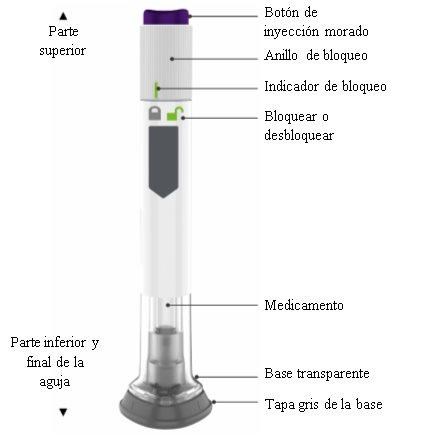
Preparing to Inject Mounjaro
Takethe pen out of the refrigerator. Leave the gray base cap on until you are ready to inject. | |
Checkthe pen label to make sure it is the correct medicine and dose and that it is not expired. Examinethe pen to make sure it is not damaged. |
|
Make sure the medicine: | |
|
|
Washyour hands. |
Choose Your Injection Site
Your doctor, nurse, or pharmacist can help you choose the best injection site for you.
| You or another person can inject the medicine into the abdomen area, at least 5 cm away from the navel, or into the thigh. |
| Another person can inject into the back of the upper arm area. Change (rotate) the injection site each week. You can use the same area of the body, but make sure to choose a different injection site in that area. |
Step 1 | Remove the Gray Base Cap |
| Make sure the pen is locked. Do notunlock the pen until you place the transparent base on your skin and are ready to inject. |
Removethe gray base cap and throw it away. Do notput the base cap back on – this could damage the needle. Do nottouch the needle. |
Step 2 | Place the Transparent Base on Your Skin, Then Unlock |
| Placethe transparent base flat on your skin in the injection area. |
| Unlockby turning the lock ring. |
Step 3 | Press and Hold for Up to 10Seconds |
| Press and holdthe purple injection button. Listenfor:
|
| You will know the injection is complete when the gray plunger is visible. |
After your injection, put the used pen in a puncture-resistant container. Dispose of the pen as instructed by your doctor, nurse, or pharmacist. |

Disposing of Your Used Pen
|
|
Storage and Handling
- For storage instructions, see section 5 of the prospectus.
- The pen has glass parts. Handle it with care. If you drop the pen onto a hard surface, do notuse it. Use a new pen for your injection.
Frequently Asked Questions
What if I see air bubbles in my pen?
Air bubbles are normal.
What if my pen is not at room temperature?
It is not necessary to bring the pen to room temperature.
What if I unlock the pen and press the purple injection button before removing the gray base cap?
Do notremove the gray base cap. Throw away the pen and get a new one.
What if there is a drop of liquid on the tip of the needle when I remove the gray base cap?
A drop of liquid on the tip of the needle is normal. Do nottouch the needle.
Do I need to keep the injection button pressed until the injection is complete?
It is not necessary, but it may help you keep the pen stable on your skin.
I heard more than two clicks during the injection – two high clicks and one low click. Is the injection complete?
Some people may hear a low click just before the second high click. This is due to the normal functioning of the pen. Do notremove the pen from your skin until you hear the second high click.
I am not sure if my pen has worked correctly.
| Check if you have received your dose. The dose has been administered correctly if the gray part is visible. Also, see Step3of the instructions. If you do not see the gray plunger, contact Lilly for further information. Until then, keep your pen safe to avoid an accidental needle stick injury. |
What if there is a drop of liquid or blood on my skin after the injection?
This is normal. Press a cotton ball or gauze onto the injection site. Do notrub the injection site.
Other Information
- If you have vision problems, do not use your pen without the help of another trained person in the use of the Mounjaro pen.
Where to Get More Information
- If you have any questions or problems with your Mounjaro pen, contact Lilly or your doctor, nurse, or pharmacist.
Last Revised
- Country of registration
- Active substance
- Prescription requiredYes
- Manufacturer
- This information is for reference only and does not constitute medical advice. Always consult a licensed doctor before taking any medication. Oladoctor is not responsible for medical decisions based on this content.
- Alternatives to MOUNJARO 12.5 mg Injectable Solution in a Pre-filled PenDosage form: INJECTABLE, 10 mgActive substance: tirzepatideManufacturer: Eli Lilly Nederland B.V.Prescription requiredDosage form: INJECTABLE, 10 mgActive substance: tirzepatideManufacturer: Eli Lilly Nederland B.V.Prescription requiredDosage form: INJECTABLE, 10 mg/doseActive substance: tirzepatideManufacturer: Eli Lilly Nederland B.V.Prescription required
Online doctors for MOUNJARO 12.5 mg Injectable Solution in a Pre-filled Pen
Discuss dosage, side effects, interactions, contraindications, and prescription renewal for MOUNJARO 12.5 mg Injectable Solution in a Pre-filled Pen – subject to medical assessment and local rules.









